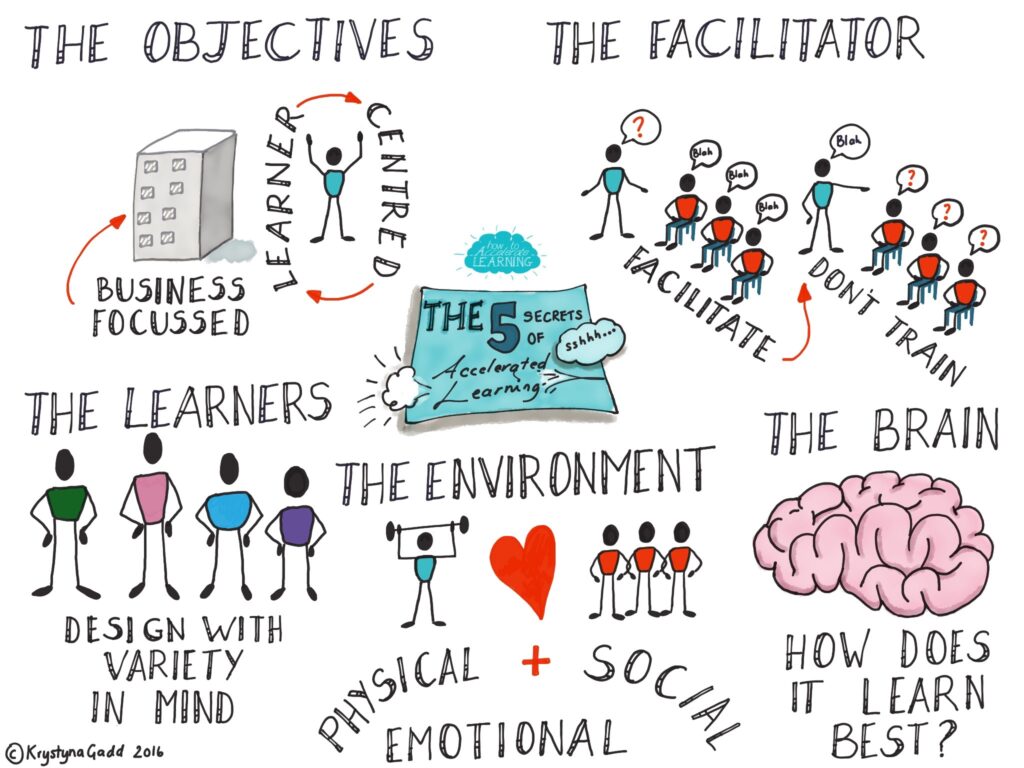In this article I’ll look at how we can use the latest neuroscience to maximise the learning retention. Last time we looked at the physical, emotional and social environments and how they can help to accelerate learning. In that article I mentioned some of the latest thinking about social learning and safety, as well as the part dopamine plays in keeping participants’ attention. These cross over into this fifth secret about the brain and knowing how it works in order to learn in the best possible way.
Let me say from the outset that I am not a neuroscientist and do not wish to take away from some of the many experts out there in this field. My fascination has never been in the brain and naming all the parts, but in the practical application of the latest neuroscience to help us in the field of learning and development.
Therefore, this article will help you to take away a handful of ‘nuggets’ from the latest neuroscience, while offering some practical applications that you can implement immediately to maximise the retention of learning.
1. Ways to increase that dopamine ‘hit’
We already know that dopamine plays a big part in engaging people, whether in a live learning situation or virtually. Dopamine activates your reward systems. It controls arousal levels in the brain.
So here are some ways in which we can arouse curiosity and increase those dopamine levels in the brain:
- Encourage competitive team activities where the rewards are uncertain (the uncertainty gets more emotional response).
- Have some attractive or unusual objects in the room, related to the subject but not wholly explained.
- In the welcome email, allude to some interesting activities that will happen, without giving the details away. Hint there may be prizes or rewards for the winners.
- Use a quiz as an introduction to a topic, where a lot of the answers will be unknown. Encourage participants to guess (see point 5 for more on this).
- Get the participants to set their own objectives for the learning.
2. Using emotion in learning
On the use of emotion in learning, Nick Shackleton-Jones (in his book, How to Learn) says, “It makes perfect sense for memory to work in this way: your memory needs to be efficient so it only stores the stuff that matters – but which stuff matters? Answer: the stuff that has an emotional impact”.
If this is true, then the connection with the content and the participants in learning has to be a strong one. They have to be brought in to the learning and its application in order for them to be engaged as fully as possible. Here are some suggestions for what you might do practically:
- Before any learning occurs, conduct a needs analysis so that you fully understand the challenges and issues facing the organisation as well as the individuals.
- Include the participants in the analysis, so that they know that their views are taken into consideration, hence encouraging more buy-in.
- As they come in to the classroom, get them to share on a flip (or brown wall as mentioned in my last article) what they want to get out of the learning.
- Engage with the participants’ line managers, so that they understand the impact of the learning and its application.
- Use stories to illustrate concepts and real-life examples to draw people in. Stories are great at helping people to visualise and empathise with a situation as well as connect with how they might fit in.
3. Teaching an old dog new tricks
There used to be a myth that brains could not change as you got older, but Eleanor Maguire conducted research that uncovered that our brains are not fixed as we had previously thought. Her study on taxi drivers in fact showed the opposite.
This does not help however, when you have participants who think that they are bad at learning. This limiting belief soon becomes a self-fulfilling prophecy. To remove this barrier, you might:
- Send them a link to the research on how we can learn. This explains that our brains have this quality of ‘neuroplasticity’ that allows us to learn new things all our adult lives.
- In the welcome email reassure them that the learning will be at a reasonable pace, made simple and straightforward, and that you will not be using jargon.
- Reassure them that it will be a safe environment to learn where they will have the support of peers and the facilitator, if in a face-to-face situation.
- Encourage them to make notes with pen and paper, because it has been shown that writing notes on the learning in their own words will increase their recall.
- Give them a little something to learn then do immediately, so that they can increase in confidence. Confidence is key.
4. Testing is an important part of the learning process
Until I read Make it Stick: The Science of Successful Learning, I thought that knowledge testing was just a way for me as a trainer or facilitator to find out whether participants had learned what they were supposed to learn. After reading this book, it became clear that testing, or ‘retrieval practice’ as it is known, is a key part of the learning process.
Here are some ways that you can make it a fun and engaging part of the learning process:
- Use flashcards, word searches or team quizzes to practice accessing the new learning.
- Ensure that you incorporate reflection as part of the learning so that the participants realise what they have learned.
- Encourage longer answers to questions about the learning rather than multiple choice or short answers. Use an activity like ‘beat the clock’ where for one whole minute they speak about whatever the topic/question is.
- Use a mixture of practice for example, interleaved practice invites testing on unrelated topics one after the other. This makes the learning more effortful and also lasting.
- Associate and apply the material to real life situations to make it more meaningful for the participants’ context (this also then links to point 2, about using emotion).
5. Guess what?
Is guessing a valid form of learning? Can it really make a difference to how much you retain? Well according to Stella Collins: “it seems, perhaps counter-intuitively, that we learn better after guessing, even if we have guessed a wrong answer first”.
“The basic idea is that this activation (the guessing) affords a richer encoding of the information,” she explains.
You can incorporate a guessing element to any learning by:
- Using a word search or similar puzzle to find all the word associated with a topic or question on the topic.
- Have a matching activity – matching terms and their meanings when introducing the new topic.
- Create a flipchart with maybe five or six numbers on it. These should be statistics related to the topic. Share a fact and let participants guess which number is related to that fact. For example, the number of people who complain compared to those people who are unhappy with a service.
- Get participants to do some case studies before they learning your tips on the topic. Follow up with a de-brief, e.g. ‘now how would you do this knowing what you know now?’
We’re now at the end of my five secrets of accelerated learning. If you’d like to catch up on the rest of these secrets you can visit the content series page here. I welcome any questions and feedback you might have in the comments below.
In this article I’ll look at how we can use the latest neuroscience to maximise the learning retention. Last time we looked at the physical, emotional and social environments and how they can help to accelerate learning. In that article I mentioned some of the latest thinking about social learning and safety, as well as the part dopamine plays in keeping participants’ attention. These cross over into this fifth secret about the brain and knowing how it works in order to learn in the best possible way.
Let me say from the outset that I am not a neuroscientist and do not wish to take away from some of the many experts out there in this field. My fascination has never been in the brain and naming all the parts, but in the practical application of the latest neuroscience to help us in the field of learning and development.
Therefore, this article will help you to take away a handful of ‘nuggets’ from the latest neuroscience, while offering some practical applications that you can implement immediately to maximise the retention of learning.
1. Ways to increase that dopamine ‘hit’
We already know that dopamine plays a big part in engaging people, whether in a live learning situation or virtually. Dopamine activates your reward systems. It controls arousal levels in the brain.
So here are some ways in which we can arouse curiosity and increase those dopamine levels in the brain:
- Encourage competitive team activities where the rewards are uncertain (the uncertainty gets more emotional response).
- Have some attractive or unusual objects in the room, related to the subject but not wholly explained.
- In the welcome email, allude to some interesting activities that will happen, without giving the details away. Hint there may be prizes or rewards for the winners.
- Use a quiz as an introduction to a topic, where a lot of the answers will be unknown. Encourage participants to guess (see point 5 for more on this).
- Get the participants to set their own objectives for the learning.
2. Using emotion in learning
On the use of emotion in learning, Nick Shackleton-Jones (in his book, How to Learn) says, “It makes perfect sense for memory to work in this way: your memory needs to be efficient so it only stores the stuff that matters – but which stuff matters? Answer: the stuff that has an emotional impact”.
If this is true, then the connection with the content and the participants in learning has to be a strong one. They have to be brought in to the learning and its application in order for them to be engaged as fully as possible. Here are some suggestions for what you might do practically:
- Before any learning occurs, conduct a needs analysis so that you fully understand the challenges and issues facing the organisation as well as the individuals.
- Include the participants in the analysis, so that they know that their views are taken into consideration, hence encouraging more buy-in.
- As they come in to the classroom, get them to share on a flip (or brown wall as mentioned in my last article) what they want to get out of the learning.
- Engage with the participants’ line managers, so that they understand the impact of the learning and its application.
- Use stories to illustrate concepts and real-life examples to draw people in. Stories are great at helping people to visualise and empathise with a situation as well as connect with how they might fit in.
3. Teaching an old dog new tricks
There used to be a myth that brains could not change as you got older, but Eleanor Maguire conducted research that uncovered that our brains are not fixed as we had previously thought. Her study on taxi drivers in fact showed the opposite.
This does not help however, when you have participants who think that they are bad at learning. This limiting belief soon becomes a self-fulfilling prophecy. To remove this barrier, you might:
- Send them a link to the research on how we can learn. This explains that our brains have this quality of ‘neuroplasticity’ that allows us to learn new things all our adult lives.
- In the welcome email reassure them that the learning will be at a reasonable pace, made simple and straightforward, and that you will not be using jargon.
- Reassure them that it will be a safe environment to learn where they will have the support of peers and the facilitator, if in a face-to-face situation.
- Encourage them to make notes with pen and paper, because it has been shown that writing notes on the learning in their own words will increase their recall.
- Give them a little something to learn then do immediately, so that they can increase in confidence. Confidence is key.
4. Testing is an important part of the learning process
Until I read Make it Stick: The Science of Successful Learning, I thought that knowledge testing was just a way for me as a trainer or facilitator to find out whether participants had learned what they were supposed to learn. After reading this book, it became clear that testing, or ‘retrieval practice’ as it is known, is a key part of the learning process.
Here are some ways that you can make it a fun and engaging part of the learning process:
- Use flashcards, word searches or team quizzes to practice accessing the new learning.
- Ensure that you incorporate reflection as part of the learning so that the participants realise what they have learned.
- Encourage longer answers to questions about the learning rather than multiple choice or short answers. Use an activity like ‘beat the clock’ where for one whole minute they speak about whatever the topic/question is.
- Use a mixture of practice for example, interleaved practice invites testing on unrelated topics one after the other. This makes the learning more effortful and also lasting.
- Associate and apply the material to real life situations to make it more meaningful for the participants’ context (this also then links to point 2, about using emotion).
5. Guess what?
Is guessing a valid form of learning? Can it really make a difference to how much you retain? Well according to Stella Collins: “it seems, perhaps counter-intuitively, that we learn better after guessing, even if we have guessed a wrong answer first”.
“The basic idea is that this activation (the guessing) affords a richer encoding of the information,” she explains.
You can incorporate a guessing element to any learning by:
- Using a word search or similar puzzle to find all the word associated with a topic or question on the topic.
- Have a matching activity – matching terms and their meanings when introducing the new topic.
- Create a flipchart with maybe five or six numbers on it. These should be statistics related to the topic. Share a fact and let participants guess which number is related to that fact. For example, the number of people who complain compared to those people who are unhappy with a service.
- Get participants to do some case studies before they learning your tips on the topic. Follow up with a de-brief, e.g. ‘now how would you do this knowing what you know now?’
We’re now at the end of my five secrets of accelerated learning. If you’d like to catch up on the rest of these secrets you can visit the content series page here. I welcome any questions and feedback you might have in the comments below.





